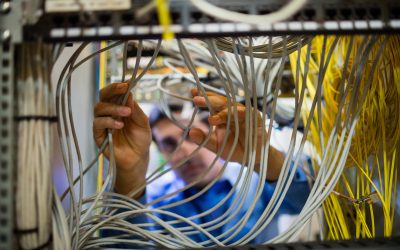Learn about testing wireless infrastructure systems

Tags: line sweep | PIM | Test Equipment | Wireless
Wireless Engineers and Testing:
A wireless communication system needs excellent integration of all components from the base station to the antenna. It is important that these components are matched from an RF standpoint. Otherwise, significant reflections will occur that degrade overall performance of the RF system.
At a cell site, antennas are connected to the transmitter/receiver with coaxial cable, or, in some cases, waveguide. When a problem, such as a break, a crushed cable, or a bad connector installation occurs in the transmission line, signal power is reduced, and the cell site falls below specified performance limits. The results are reduced coverage, dropped calls, loss of data, or missed connections. From a service provider standpoint, this results in unhappy customers that switch to a competitor resulting in lost revenue.
LINE SWEEPING
Historically, Line Sweeping was the main method of measuring the quality of a transmission line and/or antenna system. When properly applied, line sweeping accurately measures the losses in a line at any frequency and locates faults in the line. This is accomplished by performing return loss measurements and evaluating the resultant VSWR, insertion loss and distance to fault (DTF) curves.
This is certainly an important and necessary measurement, but it does not provide any information about self-generated interference that can desensitize the receiver nor does it, necessarily, confirm the true physical condition of the infrastructure. Loose, poorly fitted, or contaminated joints are not necessarily detected using this method.
The most common source of an increased noise floor within the network is poor construction quality of the components in the high power path of the base station and/or the RF interconnections between these components.
PASSIVE INTERMODULATION (PIM)
The construction quality of the components is typically verified as a part of the manufacturing process using PIM as the performance metric. PIM is an effective acceptance criterion, because it is extremely sensitive to manufacturing defects that might not be discovered through any other test or visual inspection. An unacceptably high PIM level indicates a potential for failure of the component at some point in the future. It is considerably less expensive to identify and reject or repair these components during manufacturing than after they are installed on a tower.
By contrast, the measure of construction quality at the base station site is the previously described s-parameter tests, and this is not adequate to identify construction problems that can increase the system interference/noise levels and/or lead to future component failures.
In fact, the DTF measurement often leads to the installer “tweaking” the interconnections through tightening or loosening of an RF joint to optimize the DTF performance. This action can directly lead to an intermittent RF junction, increased system noise floor, or early failure of the RF interconnection.
DETERMINING THE QUALITY OF CABLES BUILT ON SITE
Just as on the manufacturing floor, a better and more reliable method to determine the quality of construction of cables built on site, or the interconnection of these cables, or the performance of individual components, is to perform a PIM measurement. This can determine if joints are stabilized and secure, clean, and moisture free. This test can also determine if a component was delivered to the site with a less than acceptable manufacturing standard, or has deteriorated over time. In summary, the key is low transmission loss, low reflection, and low PIM generation.
FURTHER LEARNING
These aspects are covered in detail in the Cabling Science Institute’s wireless infrastructure online courses and test and troubleshooting online courses.

Written by James Donovan
You might also enjoy
FO Connector Contamination – A Constant Threat
Fiber optic communication most commonly works in duplex or multifiber transmission by transmitting light to a receiver in one direction on a fiber and receiving transmitted light back to a second receiver on the second fiber. Most engineers can understand that and...
Why Inspect and Clean Fiber Optic Connectors?
Inspecting and cleaning of fiber optic connectors during installation and when making any patching, is essential. Any contamination on a patch cord connector will be transferred through the coupler to the connector it is mated to. Even when testing fibers with a test...
Cleaning MPOs
MPO connectors should always be inspected with a scope before they are used, be that on a patch cord or a bulkhead. If they need to be cleaned, one-click cleaners are keyed to ensure the tip only fits one way onto the connectors and is able to clean both male and...


